
(Published October 2017, last updated May 2025)
As the GR 65 draws nearer to its final destination, meandering from Éauze to Saint-Jean-Pied-de-Port, it passes through some of the most spectacular scenery to be found along the Chemin de Saint-Jacques du-Puy. The lush green slopes of the Pyrénéan foothills, the crisp white houses with deep red or green window shutters stand in sharp relief to clear blue skies and fluffy white clouds.
This is French countryside at its most picturesque—dotted with tiny villages and punctuated by church steeples. And although the view is of rolling hills and distant mountains, you’ll find this to be an easy walk—mostly flat and never strenuous.

Approaching Gamarthe, located between Larceveau and Mongelos
From Éauze to Saint-Jean-Pied-de-Port, the Chemin de Saint-Jacques follows an often flat and gentle path. There are hills, of course, but the steep climbs and tricky descents are well behind you. If you have been walking for a few weeks now, you’ll find the going much easier than the first few days out of Le Puy-en-Velay.
If you have been walking for several weeks, you may be looking forward to a day of rest and relaxation. The ‘most beautiful village’ of Navarrenx, with its ancient fortified walls, historic buildings (and good range of cafés) is an ideal place to relax or explore, depending on your energy levels and tired feet.
Look inside the CHEMIN DE SAINT-JACQUES DU-PUY (PDF) guidebook
Where is the Chemin de Saint-Jacques in France?

Map of the Chemin de Saint-Jacques from Éauze to Saint-Jean-Pied-de-Port
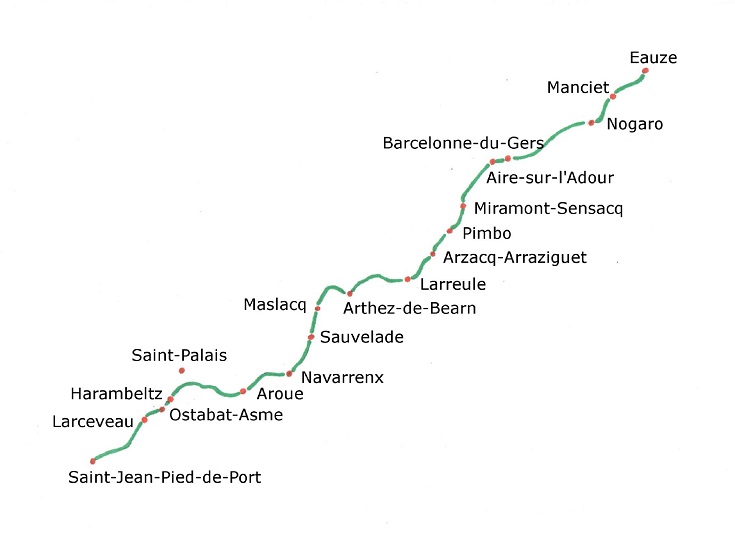

Gîte le Presbytère at Lanne Soubiran is located beside the church
Accommodation between Éauze and Saint-Jean-Pied-de-Port
Accommodation on or very close to the path is available in the following towns.
Distances are given from the starting point of Le Puy-en-Velay (and assume the shorter, traditional GR 65 path has been followed between Figeac and Cahors). If you have followed my suggested itinerary along the Célé valley, you’ll have covered 553 kilometres (345.6 miles) when you reach Éauze.
532.1 km (332.6 mi) Éauze
539.7 km (337.3 mi) La Hargue
543.1 km (339.4 mi) Manciet
547.1 km (341.9 mi) Haget
552.1 km (345.1 mi) Nogaro
560.1 km (350.1 mi) Lanne-Soubiran
556.6 km (354.1 mi) Lelin-Lapujolle
577.1 km (360.7 mi) Barcelonne-du-Gers
579.6 km (362.3 mi) Aire-sur-l’Adour
597.6 km (373.5 mi) Miramont-Sensacq
602.1 km (376.3 mi) Sensacq
606.1 km (378.8 mi) Pimbo
612.6 km (382.9 mi) Arzacq-Arraziguet
614.6 km (384.1 mi) Labalette
622.7 km (389.2 mi) Fichous Riumayou
625.1 km (390.7 mi) Larreule
632.6 km (395.4 mi) Geus-d’Arzacq
633.6 km (396 mi) Pomps
643 km (401.9 mi) Arthez-de-Béarn
650.6 km (406.6 mi) Argagnon
652.6 km (407.9 mi) Maslacq
661.1 km (413.2 mi) Sauvelade
674.8 km (421.8 mi) Navarrenx
677.1 km (423.2 mi) Castetnau-Camblong
689.6 km (431 mi) Lichos
694.4 km (434 mi) Aroue
614.6 km (446.6 mi) Harambeltz
718.1 km (448.8 mi) Ostabat-Asme
721.7 km (451.1 mi) Larceveau
730.4 km (456.5 mi) Larralde Borda
734.2 km (458.9 mi) Bussunarits
736.5 km (460.3 mi) Saint-Jean-le-Vieux
740.6 km (462.9 mi) Saint-Jean-Pied-de-Port
How to book accommodation in French

First glimpses of Nogaro, visible beyond the grapevines
Itineraries for Éauze to Saint-Jean-Pied-de-Port
As you plan your walk, remember that there are no set stages and you are free to walk as far or as little each day as you wish. Guidebooks (mine included) are often organised around a list of villages or towns but there is no advantage or obligation to follow these suggestions if the distances do not suit you.
If your preference, or an injury, dictates that no more than ten kilometres (six miles) each day is best for you, listen to your intuition and plan accordingly. On the other hand, if you know you can comfortably walk 25 or more kilometres (15 miles) each day, plan a more strenuous schedule that meets your needs.
My ten-day itinerary allows time to poke your head inside the beautiful churches you’ll pass along the way, to stop for an hour or so at Abbaye de Sauvelade and to spend most of the afternoon exploring Navarrenx.
Ten-day itinerary for Éauze to Saint-Jean-Pied-de-Port
Day 1 Éauze to Nogaro (20 km/12.5 mi)
Day 2 Nogaro to Aire-sur-l’Adour (27.5 km/17.2 mi)
Day 3 Aire-sur-l’Adour to Pimbo (26.5 km/16.6 mi)
Day 4 Pimbo to Larreule (19 km/11.9 mi)
Day 5 Larreule to Arthez-de-Béarn (17.9 km/11.2 mi)
Day 6 Arthez-de-Béarn to Sauvelade (18.1 km/11.3 mi)
Day 7 Sauvelade to Navarrenx (13.7 km/8.6 mi)
Day 8 Navarrenx to Aroue (19.6 km/12.3 mi)
Day 9 Aroue to Harambeltz (20.2 km/12.6 mi)
Day 10 Harambeltz to Saint-Jean-Pied-de-Port (26 km/16.3 mi)
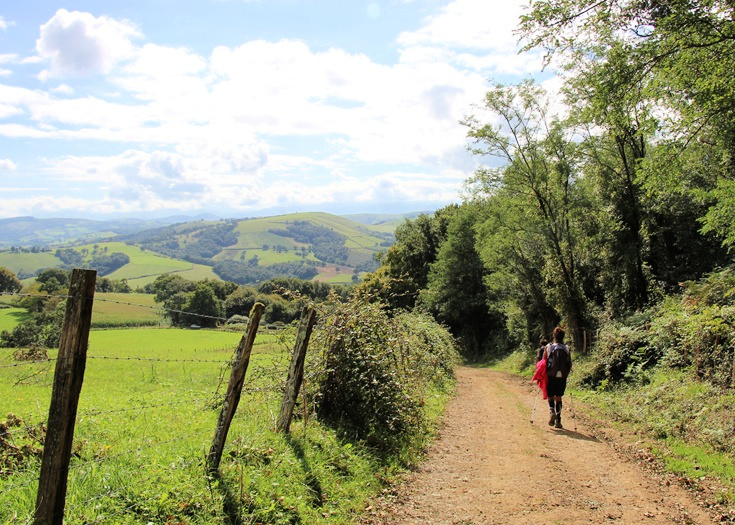
If you prefer to complete this section in nine, more evenly paced days…
Nine-day itinerary for Éauze to Saint-Jean-Pied-de-Port
Day 1 Éauze to Nogaro (20 km/12.5 mi)
Day 2 Nogaro to Barcelonne-du-Gers (25 km/15.6 mi)
Day 3 Barcelonne-du-Gers to Sensacq (25 km/15.6 mi)
Day 4 Sensacq to Larreule (23 km/14.4 mi)
Day 5 Larreule to Argagnon (25.5 km/15.9 mi)
Day 6 Argagnon to Navarrenx (24.2 km/15.1 mi)
Day 7 Navarrenx to Aroue (19.6 km/12.3 mi)
Day 8 Aroue to Harambeltz (20.2 km/12.6 mi)
Day 9 Harambeltz to Saint-Jean-Pied-de-Port (26 km/16.3 mi)
Look inside the CHEMIN DE SAINT-JACQUES DU-PUY (PDF) guidebooks

Walls of corn along the Chemin de Saint-Jacques
The best time of year to walk from Éauze to Saint-Jean-Pied-de-Port
Before reaching the splendour of the Pyrénées, the GR 65 winds through endless cornfields—tall green leafy stalks that block the view and threaten to engulf the path or, at other times, broad fields stretching as far as the eye can see.
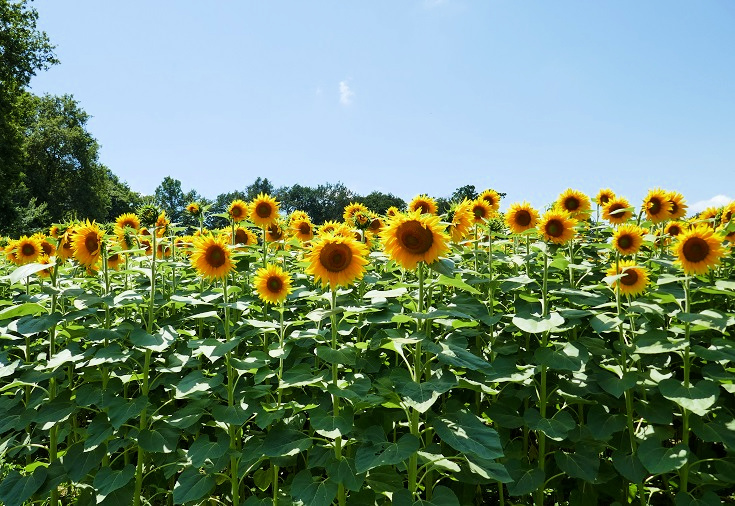
Sunflowers between Manciet and Nogaro (photo taken in early July)
Just when you think it’s all a bit monotonous, a field of sunflowers appears and those dull stalks are replaced with cheerful yellow faces.
To see the sunflowers at their best, you’ll need to walk during the summer months. France can be uncomfortably hot at this time of year with temperatures reaching 40⁰ Celsius (100⁰ Fahrenheit). Carry as much water as you can manage as there is often little shelter along the path.
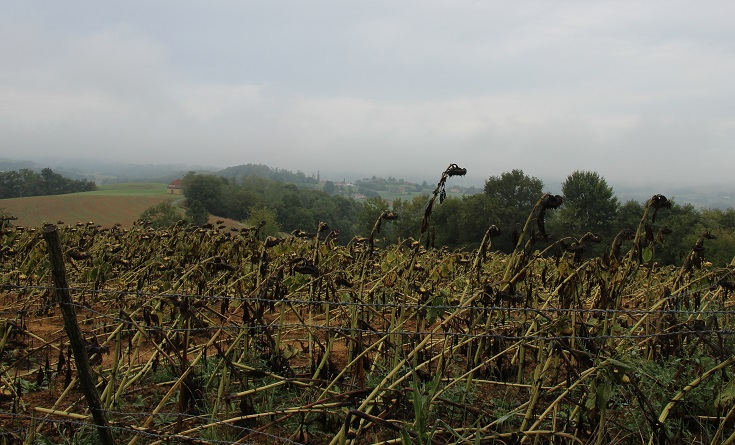
By early September, the sunflowers are well past their best and a little more imagination is needed to appreciate their beauty.
Do I need to pre-book accommodation?
Several sections of the Chemin de Saint-Jacques experience a high demand for accommodation at certain times of the year, but as you approach this final stage, you’ll find the number of other walkers decreasing.
If you enjoy participating in the communal dinner each night, booking your room and dinner the day before gives your host time to prepare and is a courtesy that is always appreciated. And if you have any special dietary considerations, a few days’ notice may be the difference between a delightful meal and settling for trail mix.
Of course, occasionally the path will be unusually busy for no apparent reason. If you know you that you will be in a certain town on a certain day, or if there is a particular hotel, chambre d’hôte or gîte that you’d like to stay at, I recommend booking your accommodation as early as possible.
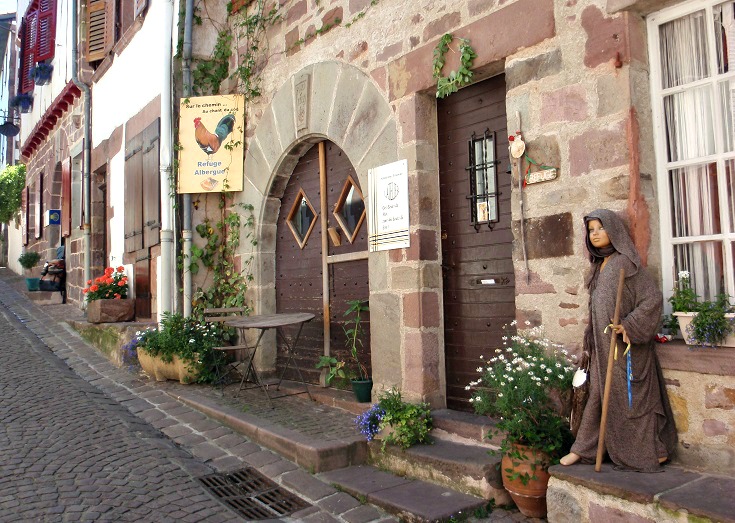
Rue de la Citadelle, Saint-Jean-Pied-de-Port
Luggage transfers
The Chemin de Saint-Jacques du-Puy is blessed with several companies who will transport your luggage on to your next destination. Make sure your bags meet all weight and size requirements, are clearly labelled and are in the foyer by 8am each morning. Your bag will be delivered to your accommodation (according to your booking instructions) later that day.
Be aware that transfer companies generally do not collect and deliver to accommodation that does not provide a secure place to leave luggage. If you book accommodation through a hotel booking website that provides access remotely via a code, you may need to make arrangements to have your bags delivered elsewhere.
Each of these companies has slightly different prices, weight limitations, and start and end of season dates. Check each one for the service that suits you best.
La Malle Postale (Le Puy-en-Velay to Aire-sur-l’Adour)
Transports Claudine (Figeac to Saint-Jean-Pied-de-Port)
Les Valises de St-Jacques (Moissac to Saint-Jean-Pied-de-Port)
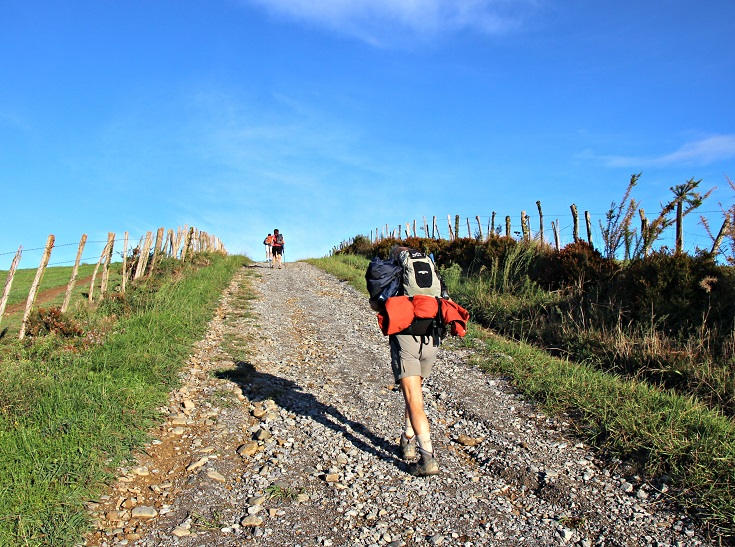
Transport options to and from Éauze
Bus line 952 Nogaro—Condom (Gers) connects Éauze with Condom, Manciet and Nogaro.
A connection at Manciet or Nogaro to bus line 934 (Gers) will take you to Auch, a major rail hub.
A connection at Condom to bus line 951 (Gers) will take you to Auch, or to bus line 953 (Gers) will take you to Agen, also a major rail hub.
Transport options to and from Saint-Jean-Pied-de-Port
Train line 54 Bayonne—Saint-Jean-Pied-de-Port will take you to Bayonne, a major rail hub.
Find many more practical tips on preparation, packing, choosing a guidebook and avoiding blisters.
Look inside the CHEMIN DE SAINT-JACQUES DU-PUY (PDF) guidebook
HIGHLIGHTS OF STAGE 5: ÉAUZE TO SAINT-JEAN-PIED-DE-PORT
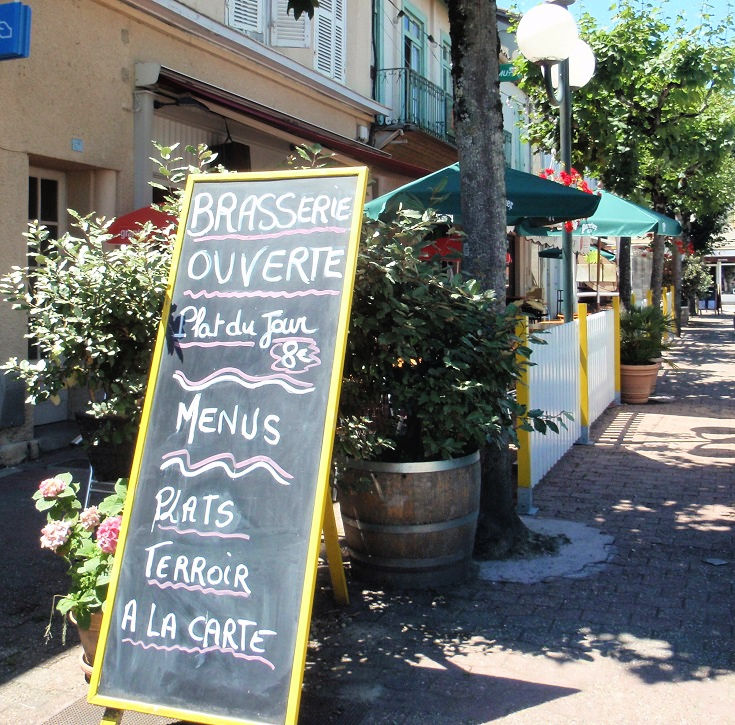
Café in Nogaro offers a cheerful welcome
Fresh food markets
Several towns along this section of the Chemin de Saint-Jacques host a weekly fresh food market. You’re sure to encounter at least one during your visit, so make the most of the varied local produce and stock up on fresh figs, nuts and other seasonal offerings to sustain you throughout the day.
Éauze—Thursday morning
Nogaro—Wednesday and Saturday mornings
Barcelonne-du-Gers—Sunday morning
Aire-sur-l’Adour—Tuesday and Saturday mornings
Arzacq-Arraziguet—Saturday morning
Arthez-de-Béarn—Saturday morning
Navarrenx—Wednesday morning (all year), Sunday morning (from May to September)
Saint-Jean-Pied-de-Port—Monday
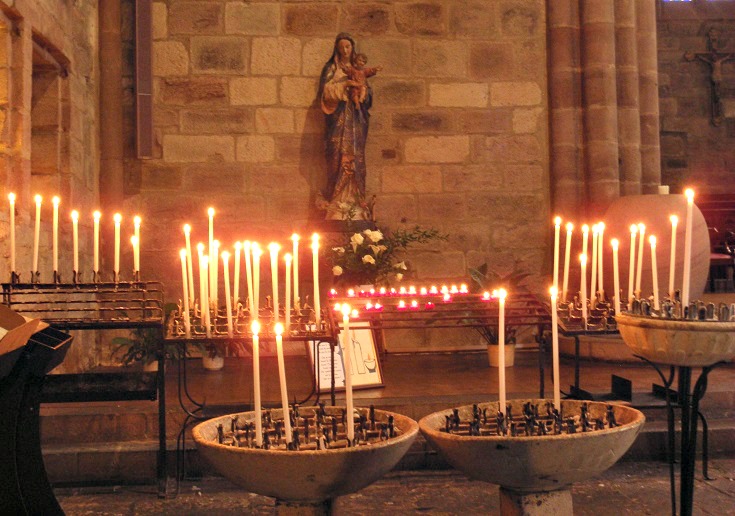
A corner of Église Notre-Dame-du-Bout-du-Pont in Saint-Jean-Pied-de-Port is set aside for candles lit by pilgrims
Visit some of France’s most beautiful churches
Between Éauze and Saint-Jean-Pied-de-Port, the chemin passes several beautiful chapels, churches and cathedrals. Some will ask only a few minutes to appreciate their beauty, others warrant a more thorough visit.
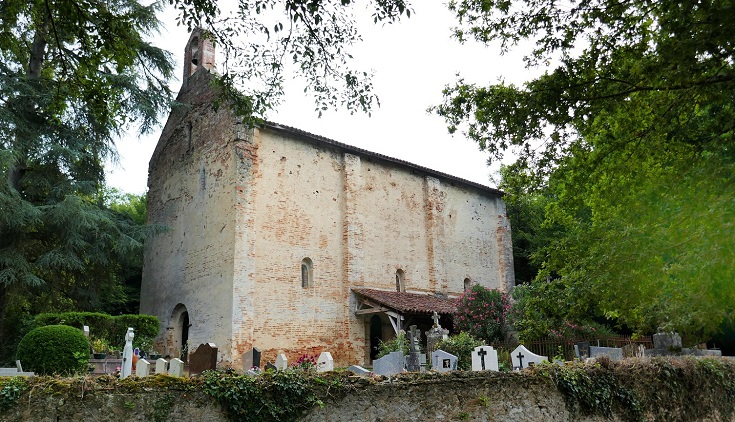
Chapelle de la Commanderie
Located in the middle of nowhere, among the endless fields between Haget and Nogaro, is Chapelle de la Commanderie which was built by the Knights of Malta in the twelfth century. At one time, the church was part of a larger complex which included a hospital and provided shelter and care to passing pilgrims.
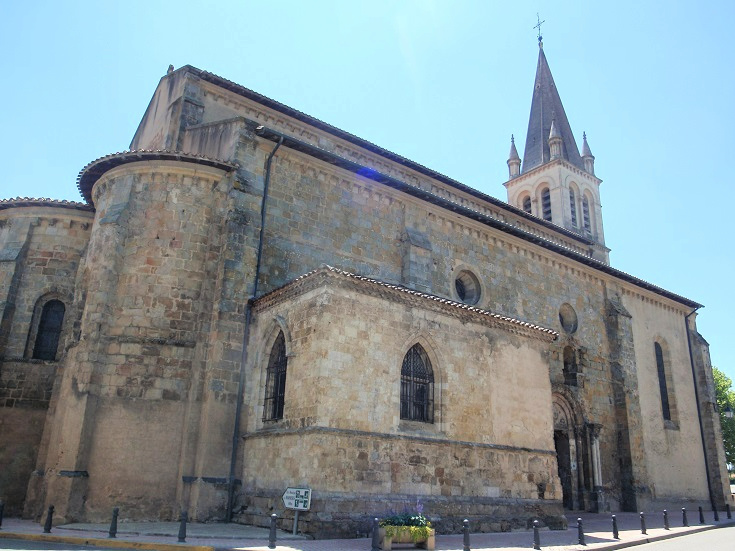
Église Saint-Nicolas, Nogaro
Église Saint-Nicolas in Nogaro was consecrated in 1060 and is one of the oldest fortified churches in southern France. Inside, you’ll find many original features, including the eleventh-century baptismal font, and frescoes dating from Roman times which are thought to be among the oldest of their kind in existence.
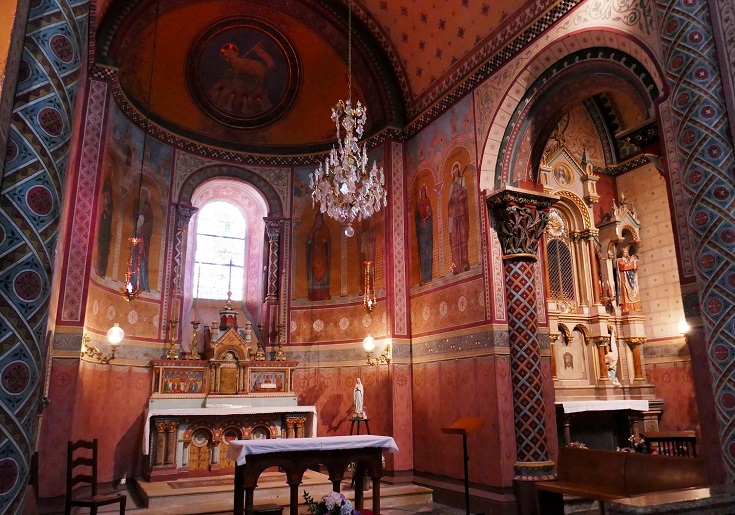
Inside Cathédrale Saint-Jean-Baptiste in Aire-sur-l’Adour
In the heart of Aire-sur-l’Adour, you’ll find Cathédrale Saint-Jean-Baptiste. First built in the eleventh century, the building has undergone several restorations to repair fire damage. The exterior is restrained, almost austere, but the interior is emblazoned with vibrantly coloured frescoes, which were added in the nineteenth century.
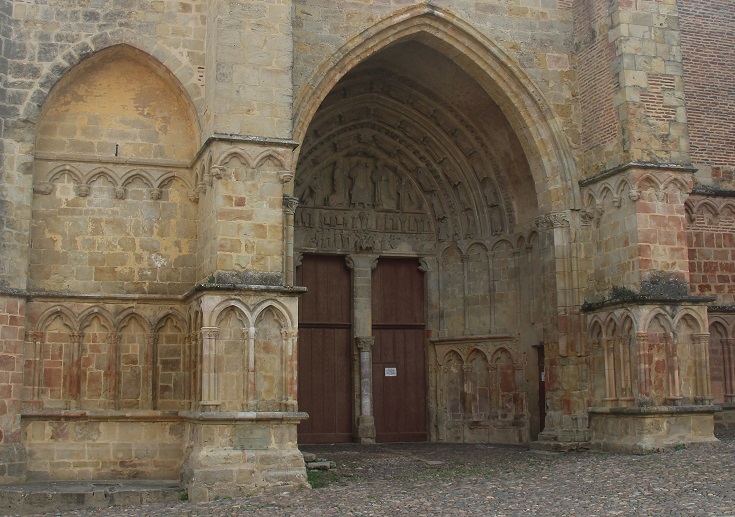
Exquisitely carved exterior of Saint-Quitterie in Aire-sur-l’Adour
As you climb the hill leaving Aire-sur-l’Adour, you’ll pass the church dedicated to Sainte-Quitterie, a fifth-century princess decapitated by her fiancée when she refused to denounce her faith and marry him. In the eleventh century, her head was brought to this place on the hill, where monks built the basilica in her honour. Three hundred years later, the building was badly damaged during the Wars of Religion, but was soon restored and now features a magnificent Gothic façade.
Guided visits are held throughout the week between mid-June and mid-September (and may be arranged at other times of the year). Visits are free and last approximately 45 minutes. Reservations are required, otherwise the guide may not attend.

Chapelle des Urselines, Aire-sur-l’Adour
Across the road from the church dedicated to Sainte-Quitterie in Aire-sur-l’Adour, is Chapelle des Ursulines. Although there had been a monastery on this site for some time, the buildings were destroyed in 1797 during the French Revolution. The current buildings were built in the last half of the nineteenth century and were in use for several decades before being abandoned and left exposed to the elements.
The chapel has since been painstakingly restored and now operates as a gîte, welcoming up to twenty pilgrims and walkers each night. To see inside, you’ll need to book a bed for the night (an experience I can thoroughly recommend following my visit in 2022).

Église de Sensacq
An hour’s walk past Miramont-Sensacq, you’ll pass l’église de Sensacq—an eleventh-century church dedicated to Saint-Jacques. At the entrance, a covered porch provides enough shelter for a dozen or so pilgrims to eat lunch or spend the night without entering the church. On the morning I passed through, the covered porch provided welcome cover from the drizzling rain, but the voices of tired pilgrims seemed to whisper through the walls, and I could easily imagine a row of blankets laid there, ready for nightfall.
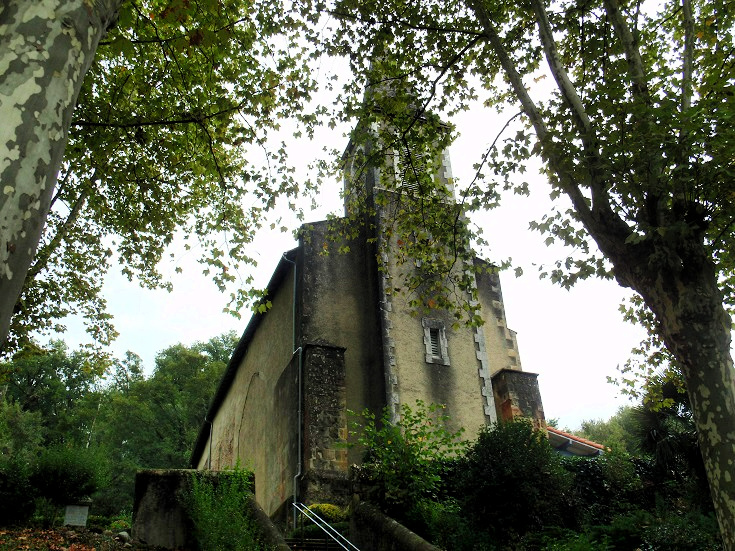
Abbaye church of Saint-Pierre, Larreule
A few hundred metres before the Chemin de Saint-Jacques reaches the village of Larreule, you’ll notice a sign pointing up the hill to the twelfth-century abbey church of Saint-Pierre.
Benedictine monks erected the first abbey church on this site towards the end of the tenth century. This was an important stop for the first pilgrims who walked this path 1,000 years ago, and many would gather here each, grateful for the food and shelter offered by the monks. The church was badly damaged in 1569 during the Wars of Religion, but rebuilding works began soon after. The bell tower was added in 1865, so the church you’ll see on your walk is a blend of ancient history and more recent restoration.
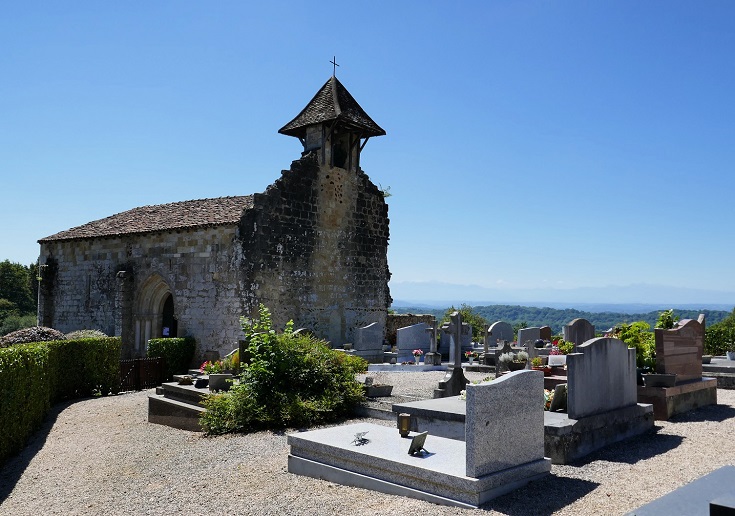
Glimpses of the Pyrénées in the distance behind Chapelle de Caubin
Two kilometres before arriving in Arthez-de-Béarn, you’ll pass a small twelfth-century chapel, Chapelle de Caubin—one of many built on the orders of Gaston IV, the first knight to enter Jerusalem during the Crusades.
Gaston returned home from battle dismayed by the senseless massacres he had witnessed, and ordered the construction of several hostels and chapels to provide shelter for pilgrims headed to Santiago. During the Wars of Religion, the hostel next to the chapel was largely destroyed, as were so many throughout France. Sadly, Chapelle de Caubin is all that remains of Gaston’s vision.
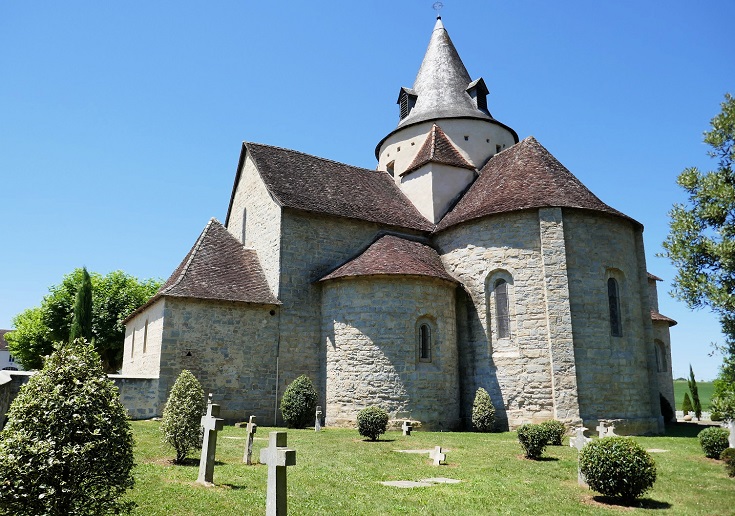
Abbaye de Sauvelade
Founded in 1128 by Gaston IV, Abbaye de Sauvelade and its monastery were gifted to an order of Benedictine monks. The abbey became an important stage on the Chemin de Saint-Jacques, as the monks provided food and shelter to the passing pilgrims. In 1789, during the French Revolution, the monastery was sold and the abbey demoted to a parish church.
In 1973, the abbey was classified as an Historic Monument and recent restoration work has returned the building to its former glory. Allow thirty minutes or so to call inside and admire the beautifully decorated interior chapels, and a wooden statue of Saint-Jacques le Majeur, gilded in goldleaf. A film chronicling the restoration of the abbey and its role in the community plays throughout the day.

The beautifully restored interior of Chapelle Saint-Nicolas
For me, the highlight of this walk was Église Saint-Nicolas in the tiny community of Harambeltz. Nestled among the farmhouses and cowsheds, its simple stone walls hide a meticulously restored baroque interior.
Since 2019, the church doors are only opened to visitors on Thursday between 2 pm and 6 pm, or for groups of ten or more visitors who have made prior arrangements. In 2022, I booked a bed at the village gîte—Etchetoa—aware that a visit inside the church was unlikely to eventuate. Late in the afternoon, a large group of Boy Scouts arrived and pitched their tents around the church grounds. You can imagine my delight when, later that evening, our host Marie announced that doors to the church were open and we were welcome to call in!
Take a closer look inside Église Saint-Nicolas and find a comprehensive list of accommodation and transport options.
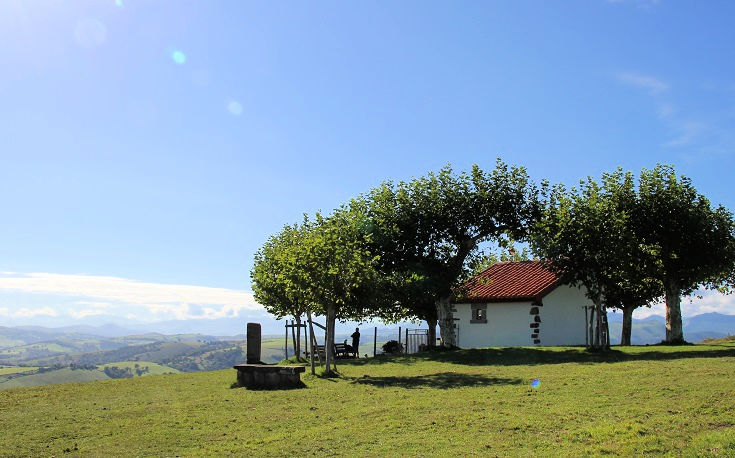
Chapelle de Soyarza
If you approach Harambeltz via the variante that passes through Uhart-Mixe, you’ll miss Chapelle de Soyarza, one of the less well-known gems along this section of the Chemin de Saint-Jacques. Instead of turning left towards Harambeltz when the variante rejoins the GR 65, turn right and continue along the GR 65 back towards Stèle de Gibraltar and Saint-Palais. After fifteen minutes or so of gentle climbing, you’ll reach the chapel and be rewarded with magnificent views of the Pyrénées.
Visit two of France’s most beautiful villages

Thick stone walls of the defensive remparts in Navarrenx
Navarrenx
Seven days after leaving Éauze, you’ll reach Navarrenx—one of France’s ‘most beautiful villages’. Surrounded by ramparts and defensive fortifications, the town occupies a commanding position overlooking the river. Take an hour, an afternoon, or perhaps a rest day, to explore the stone walls and beautiful medieval buildings.
On Wednesday mornings (throughout the year), you’ll find a fresh food market in Place Centrale Darralde and from May until September, an additional market is held in Place de la Marie every Sunday morning, making either day the perfect day to take a break.

Saint-Jean-Pied-de-Port
Three days later, your walk ends at another of France’s ‘most beautiful villages’—Saint-Jean-Pied-de-Port. The GR 65 enters the village through Porte Saint-Jacques and continues along Rue de la Citadelle—an impossibly pretty lane lined with chambres d’hôtes, souvenir shops and stores selling anything a pilgrim headed to Santiago could possibly want.
Take a closer look around Saint-Jean-Pied-de-Port and find a comprehensive list of accommodation.
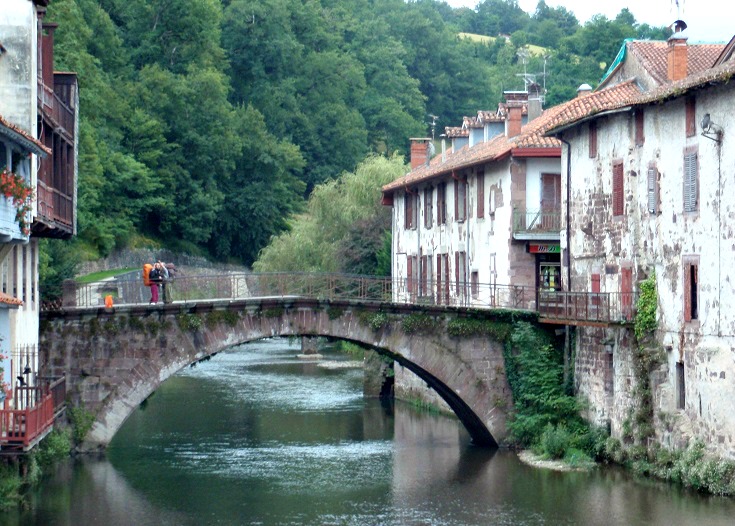
Pont Romain in Saint-Jean-Pied-de-Port
Navarrenx and Saint-Jean-Pied-de-Port are fairly recent additions to Les Plus Beaux Villages de France, gaining their classifications since 2014. Formed in 1982, with the aim of protecting and promoting the heritage and beauty of small towns throughout France, the association of Les Plus Beaux Villages de France has grown to include 180 villages scattered throughout the country.
Between Le Puy-en-Velay and Saint-Jean-Pied-de-Port, the Chemin de Saint-Jacques passes through eleven of France’s most beautiful villages.

Approaching Ostabat-Asme
Dine at a Michelin-starred restaurant
Ten kilometres from Aire-sur-l’Adour, in Eugénie-les-Bains, you’ll find the three-starred Michelin restaurant, Les Prés d’Eugénie. Michel Guérard has delighted diners here for the past forty years and is considered one of the founding fathers of nouvelle cuisine.
(It’s a little further from the trail than I’d normally venture for dinner but some opportunities come along only once in a lifetime. If you’re spending the night in Aire-sur-l’Adour and prefer not to travel far, I can thoroughly recommend the restaurant at Chez l’Ahumat.)
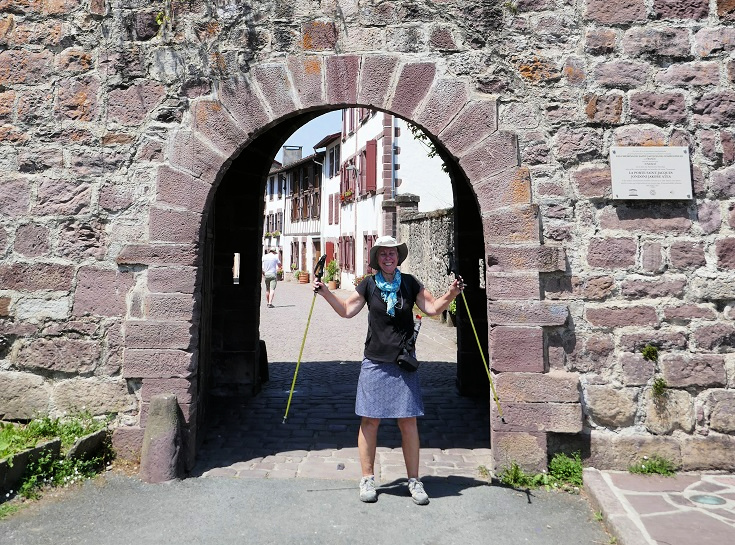
C’est moi! Arriving in Saint-Jean-Pied-de-Port on 14 July 2022—42 days after leaving Le Puy-en-Velay to walk the Chemin de Saint-Jacques du Puy
If you’ve walked the entire path from Le Puy-en-Velay, your arrival in Saint-Jean-Pied-de-Port will, no doubt, bring many mixed feelings. There will be relief and gratitude that you’ve arrived safely, that you can sleep in the next morning (and any blisters will begin to heal!). But there will also be sadness that the friends you’ve made over the past weeks will be going their own way—and that tomorrow you’ll return to the ‘real’ world of bus timetables and everyday activities.
Unless, of course, you’re continuing along the Camino Francès to Santiago…
Explore each stage in more depth:
Stage 1: Le Puy-en-Velay to Aumont-Aubrac
Stage 2: Aumont-Aubrac to Figeac
Stage 3: Figeac to Cahors
Stage 4: Cahors to Éauze
Stage 5: Éauze to Saint-Jean-Pied-de-Port
Ready to plan your walk along the Chemin de Saint-Jacques du-Puy?
Purchase the Chemin de Saint-Jacques (PDF) guidebooks
Purchase five guidebooks covering Le Puy-en-Velay to Saint-Jean-Pied-de-Port
Look inside the CHEMIN DE SAINT-JACQUES DU-PUY (PDF) guidebooks
